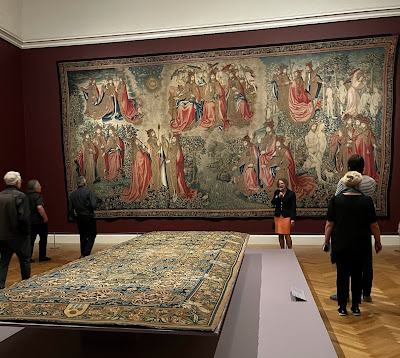Walk: Various stores: Closet Caper Returns, Hood
Distance: 2.5 miles, 4.5 miles
So, Ciwt feels like a bit of a fraud blithely citing all this CIWT information about the Tudors. She was a history major in college and still enjoys history, But English history bamboozled her. So many bloodlines, wars, murders; so much subtrafuge she had a hard time keeping it all straight. Nevertheless, onward with the Tudors in CIWT.
 |
| Elizabeth Cleland, Metropolitan Museum Curator of European sculpture and decorative presenting a tapestry at the recent Legion of Honor Press Preview of the Tudors exhibition |
At the time of his death Henry,VIII owned over 2450 highest quality tapestries. They adorned the many building works he undertook like St. James's Palace, the Palace of Nonsuch, Whitehall and Hampton Court in addition to the ones he inherited: Greenwich, Richmond and Windsor Castle. All of them as well as other residences were furnished with abundant dazzling tapestries. Sadly very little of the interior decoration of Henry's period survives. Just over 100 tapestries are left, but those are a feast for the eyes.
Tapestry was the premiere wall art in Henry VIII's age, the renaissance. By the early middle ages workshops throughout Europe were already producing textile hangings and adding prestige to well-to-do collectors. At some point an unknown artist conceived the idea of representing stories in these weavings - as opposed to merely decorative patterns - and tapestry embarked on its own glorious career in the figurative arts. Rooms hung with tapestries were designed to impress and create a majestic atmosphere. They were the primary decorative form at the royal court exceeding other works of art, including paintings, in status and expense.
Many of the best tapestries were designed by artists who were renowned painters so the figurative artwork is superb.
 |
| tapestry detail |
Often on a grand scale and woven in story telling multiples with silk threads wrapped in silver and gold it was not rare to see them covering all the walls of a huge royal room and telling historical or biblical stories. Castles were cold at best so, beyond decoration, tapetries blocked drafts and retained heat well before the advent of central heating. Because they are made of pliable fiber, they could be rolled and transported. For major state and religious ceremonies, tapestries were hung on the outside of buildings, suspended from balconies or attached directly exterior walls or lying flat on ceremonial table tops or even lining streets. Wherever they were, they were arresting, distinctive, exquisite.
Ciwt may have difficulty retaining all the nuances of English history, but she has no trouble at all being awed by the tapestries commissioned by Henry VIII.
No comments:
Post a Comment